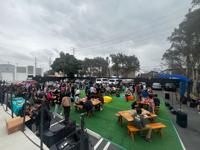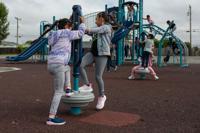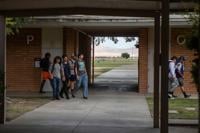
In a city built on stories but still struggling with who gets to tell them, over 300 high school students gathered in Inglewood not just to see what is possible, not just to dream—but to plan.
The GRID Creativity Summit, held on April 23 at Volume Studios in Inglewood, was more than an event. It was a collective act of imagination, strategy and resistance, which took place in the shadows of Hollywood and the music industry. Amid the soundstages and billboards, where billions are made off the labor and likeness of communities often left out of ownership, GRID offered young people—mostly Black, Brown, and first-generation—a radical counter-narrative: you belong here, not as spectators, but as architects.
For generations, communities of color have been granted access to art only through consumption. They have been the audience, the inspiration, the cultural currency—but rarely the decision-makers, producers or gatekeepers. The GRID Summit seeks to interrupt that pattern. It doesn't just expose youth to art; it opens doors into the industries behind it, equips them with language, tools and community, and insists that they have a stake in shaping the culture that so often borrows from them without credit.
“The initial premise of the GRID at the get-go was to provide a community for young people that saw themselves as creative” Loree Goffigon, director for the Center for Collaborative Learning (CCLL) tells me in the patio.
This summit is part of a broader statewide movement, a part of a larger coalition, to reimagine what equity in the creative economy can look like. Through partnerships with educators, industry professionals and grassroots organizers, CCLL has been building infrastructure that doesn’t just inspire—it sustains. This is the seventh summit servicing students across BIPOC and working class schools in Los Angeles.
The program: a deep dive into the creative economy

Throughout the day, students selected from three rounds of breakout sessions, each offering up to eight simultaneous workshops or panels. This structure ensured that students could tailor the day to their interests while gaining exposure to a broad range of creative pathways.
Across the day, students also visited the Student Showcase Gallery, where youth work was displayed, and met one-on-one with mentors through the Creative Careers Online platform.
I spoke to a few students who felt inspired. Some were already members of bands or were very interested in photography and film but didn’t know how to transition after high school into making their passions their career or see what was even available as next steps.
Why this matters: more than exposure

For youth of color across Los Angeles and beyond, access to arts education and creative career pathways often ends at exposure. But access, without infrastructure or industry visibility, is not enough. That’s where the GRID Summit stands apart. The event didn’t just introduce youth to creative professions—it embedded them into environments where these professions are made, guided by people who look like them and understand their context.
Workshops didn’t just teach design or production—they helped students navigate how to pitch their stories, present their portfolios and seek out community. For many students I talked to, this was their first time learning how to talk about their work or ask professionals about pay, internships and sustainability. These aren’t always lessons learned in art class—they're the missing links in transforming passion into profession.
CCLL’s statewide mission

The GRID Creativity Summit is part of a larger, ongoing effort by the Center for Collaborative Learning (CCLL), a nonprofit that partners with community organizations, schools and industry leaders to build sustainable learning ecosystems across California. Founded on the belief that transformative learning happens when youth are placed at the center of design, CCLL’s work spans curriculum design, workforce development and creative placemaking.
Through initiatives like GRID, CCLL has been steadily building a statewide movement to expand access to the creative economy—especially for Black, Brown, Indigenous, and immigrant youth. The organization’s work reflects the urgent need for equity not only in education, but in the industries that shape culture, narrative and representation.
In a city like Los Angeles, where creative production is a global export, equity in the arts is more than symbolic. It’s economical. It's structural. It’s generational. Events like the GRID Summit show what’s possible when those barriers begin to shift.
What comes next

With support from local schools, regional creative professionals and partners from media, design and education sectors, the 2025 GRID Summit points to a future where creative careers are no longer a dream for students of color, but a plan.
For the students who attended, the experience didn’t just offer them access—it gave them tools to take action. Whether that means applying to a college program, submitting work to a local zine or simply continuing to create, the message was clear: their work is valid, their stories are needed and their communities deserve to be seen in every frame, on every stage and behind every lens.
















(0) comments
Welcome to the discussion.
Log In
Keep it Clean. Please avoid obscene, vulgar, lewd, racist or sexually-oriented language.
PLEASE TURN OFF YOUR CAPS LOCK.
Don't Threaten. Threats of harming another person will not be tolerated.
Be Truthful. Don't knowingly lie about anyone or anything.
Be Nice. No racism, sexism or any sort of -ism that is degrading to another person.
Be Proactive. Use the 'Report' link on each comment to let us know of abusive posts.
Share with Us. We'd love to hear eyewitness accounts, the history behind an article.